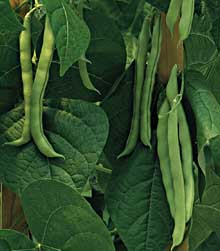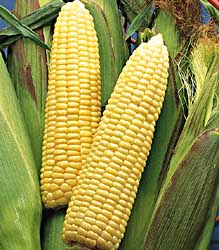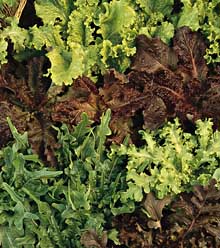| Flavor has to
top the list of reasons why a gardener would grow an heirloom variety.
After you've tasted a ripe, juicy Brandywine tomato fresh from (or right
off the plant in) your own garden in August, you'll never go back to the
store-bought kind. the rediscovery of the fabulous taste of every
kind of vintage vegetable accounts for much of the rediscovery of these
old time varieties.
The novelty of
trying something different has great appeal to gardeners, too. Heirlooms
represent much more diversity in terms of color and shape in addition to
the above mentioned taste within vegetable types than hybrids. Let's
not discount the lure of being the first on your block to grow purple potatoes
or orange eggplant, either. In this same vein, one can't leave out
the fun of growing varieties with such terrifically descriptive names.
Who could resist showing off Moon and Stars watermelon or Cherokee Trail
of Tears beans in your own garden?
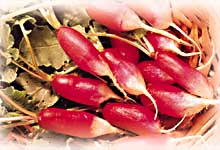 Some
gardeners, who continue to grow varieties handed down from great great
grandparents, take great pride in the historical aspect of vintage varieties
and in keeping the bond to their forebears alive in their own gardens. Some
gardeners, who continue to grow varieties handed down from great great
grandparents, take great pride in the historical aspect of vintage varieties
and in keeping the bond to their forebears alive in their own gardens.
Growing heirlooms
has reached the trendy stage in backyard vegetable plots as several commercial
seed companies now offer a few vintage varieties among their larger hybrid
selections. America's chefs have discovered the superior taste of
these vegetables and feature specially created dishes that show off the
best of the locally grown heirlooms in their locales.
It is easy to
get nostalgic about the past in the growing of these plants. One
of the most important reasons for growing historic varieties, and especially
for saving seed, is, simply, the future. By retaining the broad diversity
of the large gene pool that heirlooms represent, genetic scientists in
the decades ahead will be able to further improve varieties based on a
wide range of characteristics. In particular, the genes from heirlooms
can be used to solve some of our biggest food growing challenges: drought
tolerance, disease resistance and production of higher yields. Unless
these genetically diverse plants are grown and their seed saved, the ecological
and economic resilience of future vegetables will be diminished.
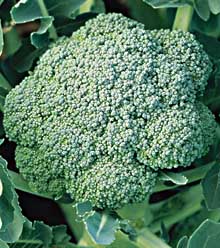 We've
discussed all the advantages of growing heirlooms. Now, what's the
downside? Well, they do not store as well as vegetables from hybrid
plants. They have a shorter shelf life. Some varieties have
a very long growing season. Open-pollinated sweet corn is an example
of a variety whose long maturity dates led to the development of modern
hybrids exhibiting much shorter maturities, as much as 40 days less in
the case of some extra early hybrids. And finally, these delicious
vegetables are more prone to disease and are not as widely adapted to as
many growing regions as most hybrids are. That said, those of us
who increasingly turn our backyard plots over to more and more heirlooms
feel that the advantages far outweigh the disadvantages. We've
discussed all the advantages of growing heirlooms. Now, what's the
downside? Well, they do not store as well as vegetables from hybrid
plants. They have a shorter shelf life. Some varieties have
a very long growing season. Open-pollinated sweet corn is an example
of a variety whose long maturity dates led to the development of modern
hybrids exhibiting much shorter maturities, as much as 40 days less in
the case of some extra early hybrids. And finally, these delicious
vegetables are more prone to disease and are not as widely adapted to as
many growing regions as most hybrids are. That said, those of us
who increasingly turn our backyard plots over to more and more heirlooms
feel that the advantages far outweigh the disadvantages.
|


